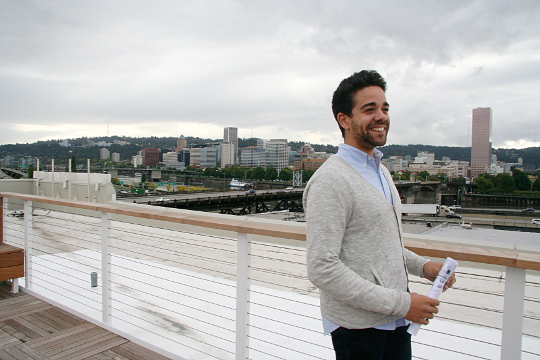
office building at NE 3rd and Couch, is a big fan of the view from the rooftop patio.
(Photo © M.Andersen/BikePortland)
Portland’s self-image as an economic laggard has never looked more out of date than it does right now in the longtime industrial district on the Central Eastside.
And the rising appeal of low-car-friendly life on Portland’s eastside grid is busting an even older stereotype: that getting a good-paying job means heading west.
“A lot of the talent, especially that a lot of these young tech companies already have or are going after as they grow, tend to live on the east side, and appreciate the culture and the types of amenities found on the east side,” said Leonard Barrett, project manager for Beam Development‘s new Eastside Exchange building.
The building, a onetime ice cream cone factory, just remodeled and opened 80,000 leasable square feet of so-called “Creative A” office space: high unfinished ceilings, big windows, shared public spaces — and lots and lots of bike, foot and transit commuters.
“We’ve been really surprised by how low the demand for parking spaces has been,” Barrett said. (The building, expected to house 350 or more employees, has 126 on-site parking spaces.) “I think you always go into this kind of thing worrying that demand is too high, that you haven’t had enough. We haven’t seen that thing here at all. … Cascade Energy is going to have over 100 people here, and they only have 33 spaces.”
Another early tenant, Trapit, has 30 employees and is expanding from Beam’s Eastbank Commerce Center. Their parking space request: two.
“They say that about half or two-thirds of their company either bikes, runs, walks or rollerblades to work,” Barrett said.
Beam has been a big part of the central eastside’s transformation since 2002. The Eastbank Commerce Center, a remodeled furniture warehouse, set the mold for Portland’s central eastside (now officially branded as “Produce Row,” named for the area’s former role warehousing the Willamette’s agricultural products) as the city’s next hotspot for office workers.
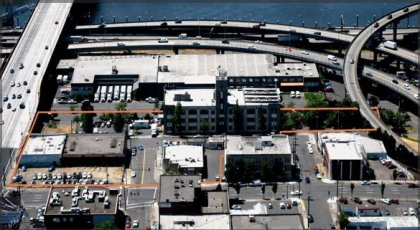
anchor hundreds of new offices and apartments
proposed for the “Burnside Bridgehead.”
Ten years ago, it might have seemed crazy: The region’s economy had been scraped raw by the decline of the U.S. wood-products industry. The tech boom (then almost entirely in the Washington County suburbs) had gone bust. And with all the region’s public transit focused on its downtown and no room for suburban-style auto parking lots, how could the relatively underserved eastside bring in enough workers to fill these new offices?
Then a few things turned in Beam’s favor. Responding to city investments like the Eastbank Esplanade, Portlanders started biking to work in big numbers — a perfect solution to the eastside’s transportation shortage. Fed by a surge of educated workers choosing to move to Portland, the tech sector rebounded, both in Washington County and Portland proper. And the rise of telecommuting and collaborative work gave a new importance to Beam’s specialty: making weird old spaces cool.
“To stay relevant as an employer, you have to create places where people really want to be.”
— Leonard Barrett, Beam Development
“To stay relevant as an employer, you have to create places where people really want to be,” Barrett said. “We try to do a really good job of curating our retail and food and drink tenants, and I think we’ve done a pretty good job with Bunk Bar, Clarklewis, Boke Bowl and Olympic Provisions.”
Finding the perfect restaurant or bar is so important to a modern office building, Beam believes, that it’ll leave spaces empty or sign sweetheart deals in order to boost the building’s long-term appeal as office space.
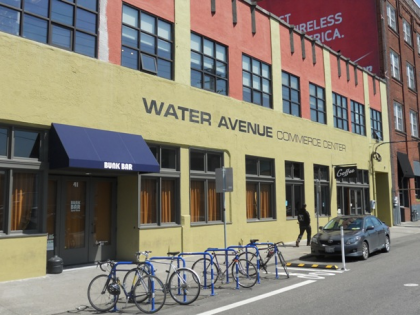
project, helped show Beam how important bike
commuting has become to startup companies.
“We’ll take an extra six months, an extra year, 18 months to find the right restaurant tenant,” Barrett said. “Maybe even if it’s not as good of a deal. We have to put more tenant improvement allowance, but we just think they’re going to nail it, and it fits with the identity of the building and it’s going to be the type of place that everyone’s going to love to be.”
With 70 indoor bike parking spaces and conversations in the works about using a massive outdoor covered bike parking structure that’s proposed next door, Beam’s team — including Barrett, 27, who bikes to work regularly himself — is putting big emphasis on bikes not just because they like them personally but because, for the Central Eastside, bikes are bringing prosperity.
The Eastside Exchange will offer larger average spaces than Beam’s other eastside office buildings, in part because the crop of startups incubated in the Eastbank Commerce Center and Water Avenue buildings are outgrowing their spaces as they become significant Portland employers. For Barrett, it’s like watching a new way of doing business take root and grow.
“We work with a lot of companies that start with two or three people, and then are 10, and then are 30,” Barrett said. “We’re pretty close to the people in the buildings and really kind of have our fingers on the pulse of what’s going on.”
— The Real Estate Beat is a weekly column. Read more here.


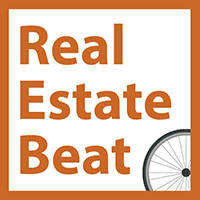
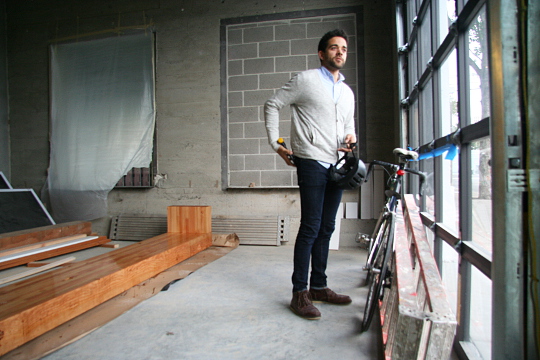

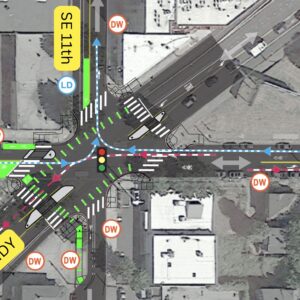


Thanks for reading.
BikePortland has served this community with independent community journalism since 2005. We rely on subscriptions from readers like you to survive. Your financial support is vital in keeping this valuable resource alive and well.
Please subscribe today to strengthen and expand our work.
I always look forward to the Real Estate Beat every week. Thank you!
Is there a photo of the exterior of the building that is not taken from the (wonderful) roof deck?
I heard that this building used to house the Phillips Co. for whom the Phillips head screw is named. Can anyone verify?
Though actually READING. Oops. And going to Beam’s Portfolio; the building is on Water and Yamhill. Not 3rd and NE Couch.
http://beamdevelopment.com/portfolio.
I didn’t think there was any high-end development going in on 3rd in the produce district. As it would be a great bank and make so much sense to bring in res or biz development, it would push the existing businesses out to where it’s cheaper; east county, St Johns, etc. They would also have to change the existing infrastructure to make it actually possible to traverse. I work occasionally down that way towards MLK/Hawthorne and since the streetcar was put in I avoid MLK and take 3rd. It’s a clusterf*ck down there with all the fork lifts, moving vans/trucks, blind corners, etc. Not bike commute friendly on NE 3rd.
Hm? The Eastside Exchange building, also known as the Convention Plaza building, is at 123 NE 3rd. The Water Avenue Commerce Center building, which is at Water and Yamhill, is also pictured above, but that’s an earlier Beam project.
I believe that Produce Row is zoned commercial- no residential. Apartments are being wildly overbuilt (real estate bubble) so we don’t need residential down there. We need jobs! I hope that the job base stays diverse, because high tech craters once a decade.
I assume this is the building he is talking about as there is only 1 building on NE 3rd and Couch. https://maps.google.com/maps?q=NE+Couch+and+3rd&hl=en&ll=45.523834,-122.662724&spn=0.001013,0.002309&sll=45.523834,-122.673404&sspn=0.008103,0.018475&hnear=NW+Couch+St+%26+NW+3rd+Ave,+Portland,+Multnomah,+Oregon+97209&t=m&z=19&layer=c&cbll=45.524014,-122.662724&panoid=OXm13eMowLAIBN3NVzJDKw&cbp=13,267.78,,1,-6.9
It has sat empty for years. Back in 2008 it was used for a political campaign offices. In 2009 the 1st floor was used as a winter warming shelter for people experiencing homelessness. The most annoying part about that was it was during the beginning of the building of the construction of the blunder which is the Burnside Couplet. After that it’s been sitting empty until they did some remodeling and cosmetic remodeling last/this year. This may not be the building he’s referring to, but it’s the only one on 3rd & NE Couch. The other one across the street is an apartment building.
Halle’s right, that’s the one. Beam’s website has some further renderings:
http://beamdevelopment.com/location/convention-plaza-burnside-bridgehead
Where are the ice cream cones made now?
China.
I’m a little disturbed that the displacement of existing jobs and workers is being ignored in this article.
The Eastside industrial area isn’t full of empty buildings, and there are a lot of working class jobs there. By essentially turning it over to “Creative A” tenants, we’re seeing more gentrification and displacement at work.
Since many industrial areas are on the outskirts of town, and/or are poorly served by public transit and bike infrastructure, you’re actually increasing the transportation burden on many of those who are least able to afford it, and in essence turning that benefit over to the comparatively wealthy “creative class” – another example of money trickling upwards.
This. We were looking at manufacturing space earlier this year and it was so difficult to find in the price range that manufacturing can pay. Freaking gentrifiers need to stop partitioning off 5,000 square foot buildings and ripping out all the industrial hookups! Why do you need your trendy web development company to be wired for 220?
The buildings mentioned in this article were vacant before being converted to their current uses.
DNF, you raise a good point – and the fact that this building was vacant before being redeveloped doesn’t change the fact that adding a bunch of homes and offices to the central eastside, even to buildings not currently being used, makes it harder in the long term for the district to also serve large industrial uses. And just as not all of us are cut out for driving trucks, not all of us are cut out for making software (I’m definitely not, for example).
But from my perspective, it’s a huge generalization to leap from “rich people tend to be office workers” to “redeveloping industrial land in the city center for offices reduces the number of decent jobs in the city center accessible to low-income people,” which is what I think you’re saying. Increasing the job density of an area, especially in a central city, has lots of secondary economic benefits that result in other jobs and higher median incomes.
http://www.transport.vic.gov.au/__data/assets/pdf_file/0005/74228/Job-density-productivity-and-the-role-of-transport.pdf
http://www.nytimes.com/2011/09/04/opinion/sunday/one-path-to-better-jobs-more-density-in-cities.html?pagewanted=all&_r=0
http://economix.blogs.nytimes.com/2010/04/13/why-humanity-loves-and-needs-cities/
http://economix.blogs.nytimes.com/2011/04/12/the-value-of-urban-clustering/
More generally, the jobs filling these buildings are the ones that the United States is competitive at producing right now. It’s hard to imagine that Portlanders of any income level would be better off if this building were home to firms employing 100 people rather than to firms employing 350.
It’s exciting to me that bikes are part of creating this rising economic tide.
Of course, I get that more dense employment (and residences) has economic benefits. But that’s actually a side issue.
Some types of employment, such as the light industrial that is common in the Eastside Industrial area, has inherently fewer jobs/acre than office work – and there’s nothing wrong with that. Light industrial jobs are important jobs, too, and they have to go somewhere.
In fairness, the zoning for the building under discussion (EX) does allow for arbitrary office uses, unlike some other parts of the Central Eastside Industrial area. However, “digital production” services, like website and software development are curiously, to my mind, allowed in the more specifically industrial zones (IG).
Having hired software developers and web designers, I feel pretty confident stating that they earn more than the typical light industrial or warehouse worker.
My concern is that redevelopment like this, and the allowed uses in the IG zones are the proverbial camel’s nose that will lead to the increasing displacement of industrial uses, and industrial workers. Just as importantly, those workers will likely be forced out to places with less access to public transportation and bike networks.
So, while the typical office worker doesn’t necessarily earn more than the typical light industrial worker, that’s often the case, and the reality is that such “digital production” work is almost guaranteed to be higher paying than the existing industrial work, and consequently there is a strong incentive for landlords to displace industrial uses in favor of the higher rents “digital production” companies can pay.
All of this leads to lower paid, lower *power* workers being deprived of jobs with easy access to public transit and bicycle infrastructure, and instead those (publicly funded) benefits accrue to office workers, and higher salaried “digital production” workers.
In short, I’m not saying “redeveloping industrial land in the city center for offices reduces the number of decent jobs in the city center accessible to low-income people.” I’m saying, “redeveloping industrial land in the city center privileges certain types of often higher paying work (office work, “digital production”) over other types often lower paying work (light industrial), and one of the consequences of that privilege is that publicly funded transportation benefits are being taken from a less-privileged class of people and given to a more-privileged one.”
Anyway, I hope that all made sense. As the apocryphal phrase goes, “Please forgive the length, I didn’t have time to make it shorter.”
Maybe a better way of putting it is that office workers already have excellent access to public transportation and bicycle infrastructure in the downtown core, why do we need to take it away from industrial workers to give office workers more?
Want more space for office workers? Force landowners to redevelop the *dozens* of square blocks of surface parking lots in the downtown core into high rise buildings and leave the industrial jobs alone.
Fair points, DNF. I don’t understand why generalized economic benefits are a side issue for you, though. If a hypothetical redevelopment replaces 100 light industrial, supervisory, administrative, support and transportation jobs at various income levels, plus the various secondary services that those people consumed throughout the area, with 350 software, design, supervisory, administrative and support jobs at various (though on average higher) income levels, plus the additional secondary services that those people consume throughout the area, plus the additional regional productivity growth made possible by more collaborations and cross-pollinations due to the greater job density, is that good or bad for underprivileged Portlanders? Seems to me like a pretty complicated question to answer.
Not that downtown couldn’t stand to redevelop some surface parking lots. But as Barrett notes, employers find the eastside attractive in part because so many of their workers live on the eastside and prefer not to cross into downtown if they don’t have to.
Generalized economic benefits are great! I’m all in favor of them – but I want them to be equitable. I said it’s a side issue because I’m trying to draw attention to issues of Economic Justice, not just Economics.
It’s about who has the power, who benefits from the power, and who suffers.
Converting the Eastside Industrial area when there’s *plenty* of land just across the river, with room for tens of thousands of office workers and doing it while depriving certain classes of workers of easy access to public transportation and bicycle infrastructure is not Justice.
There’s so much buried in the quote you gave, “…employers find the eastside attractive in part because so many of their workers live on the eastside and prefer not to cross into downtown if they don’t have to.”
But that’s true of all workers, not just the office workers. But the solution doesn’t seem to be making the office workers ride the bus for five more whole minutes into downtown, the solution is to relocate the industrial workers *much* further out, away from the quality public transportation and bicycle infrastructure.
The questions I’m asking is “Why are industrial workers less deserving of that benefit?”
Look, if we were to say to the industrial workers, “Hey, we need the space,” (which we absolutely do not right now, as has been noted), “so we’re going to ask you to move out to Swan Island, Columbia Blvd, Hayden Island, etc. But to keep your jobs accessible, we’re going to invest in frequent bus service to those areas and we’re going to add bike infrastructure that keeps you safe from freight traffic,” then this might be a different conversation.
But we aren’t doing that, we’re just saying “Office workers are more valuable than you. Get out.”
On a lighter(?) note, things like this always remind me of the The Thermals’ great song “Power doesn’t run on nothing.” (http://www.youtube.com/watch?v=tn0tynVsrTM)
[…]
they’ll give us what we’re asking for
cause either way we’re gonna take it
our power doesn’t run on nothing
we need the land you’re standing on
so let’s go, move it
you need to let go, move it
we’re more equal
we’ll move you people off the planet
cause goddamn, we need the fuel
[…]
they’ll give us what we’re asking for
cause god is with us
and our god is the richest
our power doesn’t run on nothing
[…]
do you think we’ll cease?
do you see a reason?
do you think it’s fair?
do you think it’s fair?
do you think we care?
I’ve worked in one of Beam’s buildings on Water Ave for several years and love the combination of creative/tech and industrial businesses in the area — both types seem to be going strong. There are many buildings still entirely devoted to light manufacturing, industrial material wholesalers, warehouses and food distribution. I don’t get the sense that one type of business is displacing the other so much as filling in the empty spaces. I hope that is the case, and that we can preserve this nice balance.
On the other hand I do NOT want to see residential housing incorporated into this neighborhood. This is a noisy area with trucks loading and unloading all the time and trains screaming by. It’s one of the few areas in the central city where it’s okay to make a mess and lots of noise, whether that happens to involve manufacturing or flamenco dancing. (Go Stomptown Collective!) As soon as you bring apartments and condos in, we turn into another Pearl District.
Does anyone know if if a n/s bike route under I-84 has ever been considered? A cool route could be 2nd north of Stark, and Water south. This could connect to a bunch of the bridges, and get people in inner SE across 84. Getting across the tracks is a pretty serious obstacle, but doesn’t seem impossible. The route could climb up the bank to Lloyd, connect to Rose Quarter, new developments along Multnomah, future Sullivan Gulch Trail, future NP Greenway Trail.
I do not think it is on anyone’s radar currently since a bridge. Over the tracks would be needed. The push is for a 7th avenue overpass. The space for that connection to water is there and could be added to the Sullivan’s Gulch trail if built, but it was not included in the 10% design plans.
I work in one of Beam’s buildings in this area and enjoy the bike commute, especially the Esplanade portion. One connection that really needs improvement: If you turn off the Esplanade onto Salmon, you hit an extremely rough stretch of pavement with railroad tracks embedded at an awkward angle. Turning left onto Water is challenging with parked cars blocking visibility. I feels safer taking the sidewalk to the Water/Taylor intersection and then crossing. But the sidewalk itself is a narrow obstacle course of broken concrete, random sign poles and a sagging chain link fence.
Not sure who manages these surfaces, but a little love would go a long way here… This is a connection popular with people who work here as well as visitors to OMSI and the Esplanade.
Most light industrial and commercial development is now occurring in the Columbia Corridor, which was rezoned in the 1980s and has better access for trucks, as well as better proximity to rail and air terminals.
The CEID is a dinosaur and, with its prime inner city location, gentrification is probably inevitable, especially once the new bridge opens.